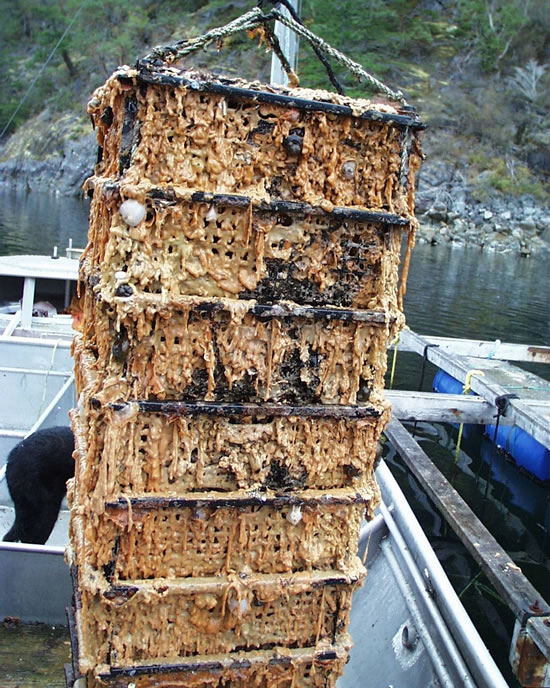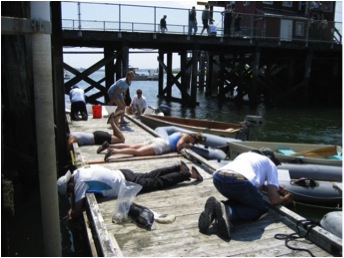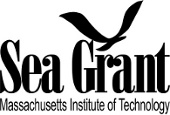Featured Stories | October 23, 2013
One Step Ahead of the Next Marine Invader
By Genevieve Wanucha
When University of Rhode Island marine biologist Niels Hobbs first started researching New England’s coastal ecosystem in 1997, he could predict how many native rock crabs he would find hiding under a given-sized rock—about one or two. Within a year, he could turn over the same rock and find 10 or 20 Asian shore crabs, Hemigrapsus sanguineus. “It was quite startling,” he says. “Very abrupt.” This little invader crab, which was first discovered in New Jersey in 1988, quickly wiped out native crabs and now threatens mussel populations on Massachusetts’ beaches. “This really is a clear case of an invasion.”
Marine invasions of East Coast marine ecosystems have escalated as modern boats dump out ballast water and arrive with fouled hulls covered in foreign critters. Several are causing expensive damage to ecosystems and rich fishing grounds such as Georges Bank. There’s the Japanese sea squirt Didemnum vexillum that covers large areas of the sea floor in pancake batter-looking material, smothering stationary wildlife and preventing fish from reaching their food below the mat. Other non-native invertebrates encrust shellfish cages, boat hulls, and buoys. The Asian green alga Codium fragile displaces eelgrass habitats and mucks up beaches when it washes ashore and decays with a noxious odor.

“There are a plethora of non-natives out here,” says James Carlton, marine ecologist at Williams College and Director of the Williams College-Mystic Seaport Maritime Studies Program. “We just keep our fingers crossed that we don’t get a predator or parasite invasion that knocks the heart out of an important shellfish industry in a place like Long Island Sound or Cape Cod.”
Yet, records of non-native organisms are spotty, making it difficult to understand their impact and spread over time. In an effort to better detect problematic marine invasions, an international team of field biologists and taxonomists led by Carlton and MIT Sea Grant’s Judy Pederson has just compiled a ten-year record of the non-native species in New England.
The 20-member team conducts rapid assessment surveys, in which they collect and identify the native and non-native species that they pull up in handfuls from the docks, ropes, buoys, chains, and hulls at marina sites on a one-week trip from Maine down to New York City. The key word here is “rapid.” The team hits the road at sunrise to make the first of a day’s three site visits. They have one hour to collect organisms, zip them into plastic bags and store them in ice-filled coolers.
“It’s really intensive sampling,” says Sara Grady, the Mass Bays South Shore Regional Coordinator, who served as the master timekeeper on the marinas this past August, making sure the ecologists and taxonomists—who would happily spend all day on the dock if they could—stick to the schedule.
After a site sweep, everyone packs back into the rental vans to travel to the next marina on their southern route. The team finishes the fieldwork by early afternoon, when they head to lab space at a local university. There, they work until eleven at night to identify the living organisms using dissecting and compound microscopes, good lighting, forceps and probes, a stack of taxonomic guides, and plenty of coffee. They send the really mysterious species to other labs for identification or deeper genetic analysis. However, many species go unidentified each year because of a lack of taxonomists who possess rare specializations in phyla such as sea sponges.

The rapid assessment surveys have now been performed every 3 years since 2000, providing a solid baseline inventory from which to assess the number and spread of invasive species along the East Coast. “It will also serve as a sentinel system for front-line early detection of any new invasion,” says Niels Hobbs, who joined the first survey soon after witnessing the aggressive Asian shore crabs in action.
The team has tracked a steady increase of new additions to New England coastal fauna, despite a lot of expensive management of ship ballast water. For example, in the 2010 survey, the team made the first North American discovery of a European shrimp in Salem, Massachusetts. It has now spread along the coast and dominates formerly abundant native shrimp populations. “We are seeing a big displacement of the native species by the new invaders,” says Pederson, “and no one has really documented the change for most of them.” Whether non-native shrimps will become food for fish, the researchers simply don’t know yet.
Then there are the species that Carlton calls “eyebrow raisers” because they have no previous record north of Florida. This year, the team found four such species, including the Florida grass shrimp all the way up in Woods Hole, Massachusetts. To Carlton, they are harbingers of climate change. “We expect to see southern species steadily move north as the waters continue to warm,” he says, “and, eventually, to see them survive the winter and become established.” The surveys will help researchers track how entire East Coast ecosystems, not just single species, respond to shifting water temperature, salinity, and ocean acidity.
These time-series “Polaroid snapshots” of species diversity are one of the only such projects in the world that’s staying one step ahead of marine invaders. “Yet, for most people,” says Pederson, “marine invaders are out of sight and out of mind, but are as problematic as invasive weeds in our back yards.”








